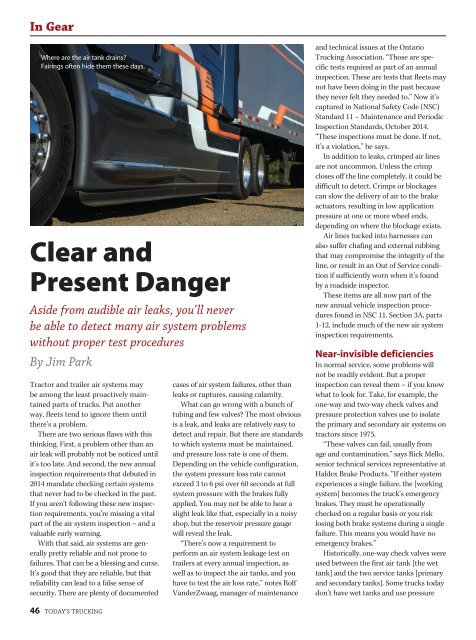DIGGING IN
2faRCNO
2faRCNO
Create successful ePaper yourself
Turn your PDF publications into a flip-book with our unique Google optimized e-Paper software.
In Gear<br />
Where are the air tank drains?<br />
Fairings often hide them these days.<br />
Clear and<br />
Present Danger<br />
Aside from audible air leaks, you’ll never<br />
be able to detect many air system problems<br />
without proper test procedures<br />
By Jim Park<br />
Tractor and trailer air systems may<br />
be among the least proactively maintained<br />
parts of trucks. Put another<br />
way, fleets tend to ignore them until<br />
there’s a problem.<br />
There are two serious flaws with this<br />
thinking. First, a problem other than an<br />
air leak will probably not be noticed until<br />
it’s too late. And second, the new annual<br />
inspection requirements that debuted in<br />
2014 mandate checking certain systems<br />
that never had to be checked in the past.<br />
If you aren’t following these new inspection<br />
requirements, you’re missing a vital<br />
part of the air system inspection – and a<br />
valuable early warning.<br />
With that said, air systems are generally<br />
pretty reliable and not prone to<br />
failures. That can be a blessing and curse.<br />
It’s good that they are reliable, but that<br />
reliability can lead to a false sense of<br />
security. There are plenty of documented<br />
cases of air system failures, other than<br />
leaks or ruptures, causing calamity.<br />
What can go wrong with a bunch of<br />
tubing and few valves? The most obvious<br />
is a leak, and leaks are relatively easy to<br />
detect and repair. But there are standards<br />
to which systems must be maintained,<br />
and pressure loss rate is one of them.<br />
Depending on the vehicle configuration,<br />
the system pressure loss rate cannot<br />
exceed 3 to 6 psi over 60 seconds at full<br />
system pressure with the brakes fully<br />
applied. You may not be able to hear a<br />
slight leak like that, especially in a noisy<br />
shop, but the reservoir pressure gauge<br />
will reveal the leak.<br />
“There’s now a requirement to<br />
perform an air system leakage test on<br />
trailers at every annual inspection, as<br />
well as to inspect the air tanks, and you<br />
have to test the air loss rate,” notes Rolf<br />
VanderZwaag, manager of maintenance<br />
and technical issues at the Ontario<br />
Trucking Association. “Those are specific<br />
tests required as part of an annual<br />
inspection. These are tests that fleets may<br />
not have been doing in the past because<br />
they never felt they needed to.” Now it’s<br />
captured in National Safety Code (NSC)<br />
Standard 11 – Maintenance and Periodic<br />
Inspection Standards, October 2014.<br />
“These inspections must be done. If not,<br />
it’s a violation,” he says.<br />
In addition to leaks, crimped air lines<br />
are not uncommon. Unless the crimp<br />
closes off the line completely, it could be<br />
difficult to detect. Crimps or blockages<br />
can slow the delivery of air to the brake<br />
actuators, resulting in low application<br />
pressure at one or more wheel ends,<br />
depending on where the blockage exists.<br />
Air lines tucked into harnesses can<br />
also suffer chafing and external rubbing<br />
that may compromise the integrity of the<br />
line, or result in an Out of Service condition<br />
if sufficiently worn when it’s found<br />
by a roadside inspector.<br />
These items are all now part of the<br />
new annual vehicle inspection procedures<br />
found in NSC 11. Section 3A, parts<br />
1-12, include much of the new air system<br />
inspection requirements.<br />
Near-invisible deficiencies<br />
In normal service, some problems will<br />
not be readily evident. But a proper<br />
inspection can reveal them – if you know<br />
what to look for. Take, for example, the<br />
one-way and two-way check valves and<br />
pressure protection valves use to isolate<br />
the primary and secondary air systems on<br />
tractors since 1975.<br />
“These valves can fail, usually from<br />
age and contamination,” says Rick Mello,<br />
senior technical services representative at<br />
Haldex Brake Products. “If either system<br />
experiences a single failure, the [working<br />
system] becomes the truck’s emergency<br />
brakes. They must be operationally<br />
checked on a regular basis or you risk<br />
losing both brake systems during a single<br />
failure. This means you would have no<br />
emergency brakes.”<br />
Historically, one-way check valves were<br />
used between the first air tank [the wet<br />
tank] and the two service tanks [primary<br />
and secondary tanks]. Some trucks today<br />
don’t have wet tanks and use pressure<br />
46 TODAY’S TRUCK<strong>IN</strong>G


